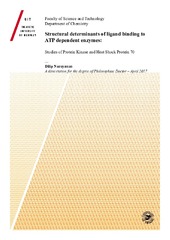| dc.contributor.advisor | Alan Engh, Richard | |
| dc.contributor.author | Narayanan, Dilip | |
| dc.date.accessioned | 2017-06-14T12:49:53Z | |
| dc.date.available | 2017-06-14T12:49:53Z | |
| dc.date.issued | 2017-04-07 | |
| dc.description.abstract | Enzymes are protein molecules that accelerate, or “catalyze”, specific chemical reactions. The reacting molecules, or substrates, bind to the enzyme which then enables their effective conversion into different product molecules. Virtually all metabolic processes in the cell need enzymes to occur at speeds fast enough to maintain life.
The kinases are a large group of phosphotransferases, i.e. enzymes which catalyze the transfer of the gamma-phosphate group from an adenosine-5-triphosphate (ATP, as phosphate donor) to a hydroxyl group (acceptor) of specific substrates. Protein kinases transfer the phosphate groups to other proteins as substrates. These processes enable the cell to transfer signals between different components of the cell that control essential processes. Tyrosine protein kinases transfer them to the phenolic hydroxyl group of amino acid residues in proteins called tyrosine, while serine/threonine protein kinases transfer the phosphate groups to the alcohol group of the serine or threonine amino acid residues.
Protein kinases also represent a key interest in the pharmaceutical industry, because they are considered therapeutic targets for diseases, including e.g. diabetes, neurodegenerative diseases, Alzheimer's disease, herpes simplex virus infection, malaria, but especially for cancer. Since the year 2001, some 30 cancer drugs that block the activity of cancer causing protein kinases have been approved.
This project describes basic chemical research of protein-ligand interactions, using key cancer drug targets as model enzymes. The research is designed to advance basic knowledge of the chemical recognition mechanisms of enzymes, and enable the design of new and improved therapeutic inhibitors. The first part of this work, represented by two published papers and a submitted manuscript, analyzes inhibitor interactions in key tyrosine protein kinases involved in cancers, including Abl (a leukemia target) and EGFR (a lung cancer target). These analyses optimize approaches to identify new inhibitors with potentially improved protein kinase inhibition profiles to forestall the development of drug resistance. The second part analyses the ATP and potential inhibitor binding site of a different class of enzyme involved in cancer, a “heat shock protein”. Finally, a draft manuscript analyses the geometric variability of a key amino acid residue of protein kinases that is often involved in drug resistance generation. The key technologies used in this project are chemical synthesis; enzyme purification, crystallography, SPR spectroscopy, and molecular modeling. | en_US |
| dc.description.doctoraltype | ph.d. | en_US |
| dc.description.popularabstract | Enzymes are protein molecules that catalyze specific chemical reactions. They play key roles in all cellular processes necessary to sustain life. Kinases are large group of phosphotransferases, enzymes that catalyze the transfer of the gamma-phosphate group from an adenosine-5-triphosphate to a hydroxyl group of associated selected substrates. Protein kinases transmit phosphate groups to other proteins as substrates. These processes allows the cell to transmit signals between different cell components that control critical processes. Tyrosine protein kinases transfer these to the phenolic hydroxyl group of the amino acid tyrosine, while serine / threonine protein kinases transfer phosphate groups of the alcohol group in the amino acid serine or threonine.
Protein kinases also represent a focus of interest in the pharmaceutical industry, since they are considered as therapeutic targets for diseases including e.g. diabetes, neurodegenerative diseases, Alzheimer's Disease, infection, malaria, but especially against cancer. Since 2001, around 30 cancer treatments that block the activity of carcinogenic protein kinases have been approved.
This project describes basic chemical research on protein-ligand interactions, using important cancer treatment targets as model enzymes. This research is intended to expand basic knowledge about the mechanisms of chemical recognition used by enzymes, and enable the design of new and improved therapeutic inhibitors. The first part of this work, which includes two published articles and one submitted manuscript, analyzes inhibitor interactions in central tyrosine protein kinases involved in cancer, including Abl (a leukemia target) and EGFR (a lung cancer target). These analyzes optimizes approaches to identify new inhibitors with possibly enhanced protein kinase inhibition profiles to prevent the development of drug resistance. Another manuscript describing the geometric variability of the central amino acid of the protein kinases which often are involved in the development of drug resistance. The second part analyzes the binding site for ATP and possibly inhibitors of another enzyme class involved in cancer, a "heat shock protein". Key technologies used in this project are chemical synthesis, enzyme purification, crystallography, SPR spectroscopy and molecular modelling. | en_US |
| dc.description.sponsorship | Norwegian Research Council Project 191303 | en_US |
| dc.description | The papers I, IV and V of this thesis are not available in Munin.<br><br>
Paper I: Narayanan, D., Gani, O. A., Gruber, F. E. Engh, R. A.: "Data Driven Polypharmacological Drug Design for Lung Cancer: Analyses for targeting ALK, MET and EGFR". (Manuscript). Published version available in <a href=https://doi.org/10.1186/s13321-017-0229-8> Journal of Cheminformatics 2017, 9:43. </a>
<br><br>
Paper IV: Narayanan, D, Alam, K. A., Gani, O. A., Engh, R. A. "On methionine as a selectivity determinant for protein kinase inhibitors". (Manuscript).
<br><br>
Paper V: Narayanan, D., Pflug, A., Christopeit, T., Kyomuhendo, P. Engh, R. A.: "Nucleotide binding and hydrolysis of Hsp70 (NBD)". (Manuscript). | en_US |
| dc.identifier.isbn | 978-82-8236-248-1 (trykt) og 978-82-8236-249-8 (pdf) | |
| dc.identifier.uri | https://hdl.handle.net/10037/11147 | |
| dc.language.iso | eng | en_US |
| dc.publisher | UiT Norges arktiske universitet | en_US |
| dc.publisher | UiT The Arctic University of Norway | en_US |
| dc.rights.accessRights | openAccess | en_US |
| dc.rights.holder | Copyright 2017 The Author(s) | |
| dc.subject.courseID | DOKTOR-004 | |
| dc.subject | VDP::Mathematics and natural science: 400::Basic biosciences: 470::Biochemistry: 476 | en_US |
| dc.subject | VDP::Matematikk og Naturvitenskap: 400::Basale biofag: 470::Biokjemi: 476 | en_US |
| dc.title | Structural determinants of ligand binding to ATP dependent enzymes: Studies of Protein Kinase and Heat Shock Protein 70. | en_US |
| dc.type | Doctoral thesis | en_US |
| dc.type | Doktorgradsavhandling | en_US |


 English
English norsk
norsk

